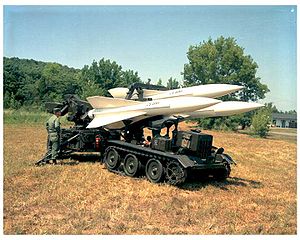MIM-23 Hawk
| MIM-23 Hawk | |
|---|---|

MIM-23 Hawk
|
|
| Type | Surface-to-air missile |
| Place of origin | United States |
| Service history | |
| In service | August 1960–present |
| Production history | |
| Manufacturer | Raytheon Corporation |
| Unit cost | $250,000 per missile $15 million per fire unit $30 million per battery |
| Specifications | |
| Weight | 1,290 pounds (590 kg) |
| Length | 16 feet 8 inches (5.08 m) |
| Diameter | 14.5 inches (370 mm) |
| Warhead | 119 pounds (54 kg) blast fragmentation warhead |
|
|
|
| Engine | solid-fuel rocket engine |
| Wingspan | 3 feet 11 inches (1.19 m) |
|
Operational
range |
45–50km |
| Flight ceiling | 65,000 feet (20,000 m) |
| Speed | Mach 2.4 |
|
Guidance
system |
Semi-active radar homing |
The Raytheon MIM-23 Hawk (Homing All the Way Killer) is a U.S. medium-range surface-to-air missile. It was designed to be a much more mobile counterpart to the MIM-14 Nike Hercules, trading off range and altitude capability for a much smaller size and weight. Its low-level performance was greatly improved over Nike through the adoption of new radars and a continuous wave semi-active radar homing guidance system.
Hawk was originally intended to attack aircraft, especially those flying at medium and low altitudes. It entered service with the Army in this role in 1959. In 1971 it underwent a major improvement program as the Improved Hawk, or I-Hawk, which made several improvements to the missile and replaced all of the radar systems with new models. Improvements continued throughout the next twenty years, adding improved ECCM, a potential home-on-jam feature, and in 1995, a new warhead that made it capable against short-range tactical missiles. Jane's reported that the original system's single shot kill probability was 0.56; I-Hawk improved this to 0.85.
Hawk was superseded by the MIM-104 Patriot in US Army service by 1994. The last US user was the US Marine Corps, who used theirs until 2002 when they were replaced with the man-portable short-range FIM-92 Stinger. The missile was also produced outside the US in Western Europe, Japan and Iran. Although the U.S. never used the Hawk in combat, it has been employed numerous times by other nations. Approximately 40,000 of the missiles were produced.
Development of the Hawk missile system began in 1952, when the United States Army began studies into a medium-range semi-active radar homing surface-to-air missile. In July 1954 development contracts where awarded to Northrop for the launcher, radars and fire control systems, while Raytheon was awarded the contract for the missile. The first test launch of the missile then designated the XSAM-A-18 happened in June 1956. By July 1957 development was completed, by which time the designation had changed to XM3 and XM3E1. Very early missiles used the Aerojet M22E7 which was not reliable; the problems were resolved with the adoption of the M22E8 engine.
...
Wikipedia
